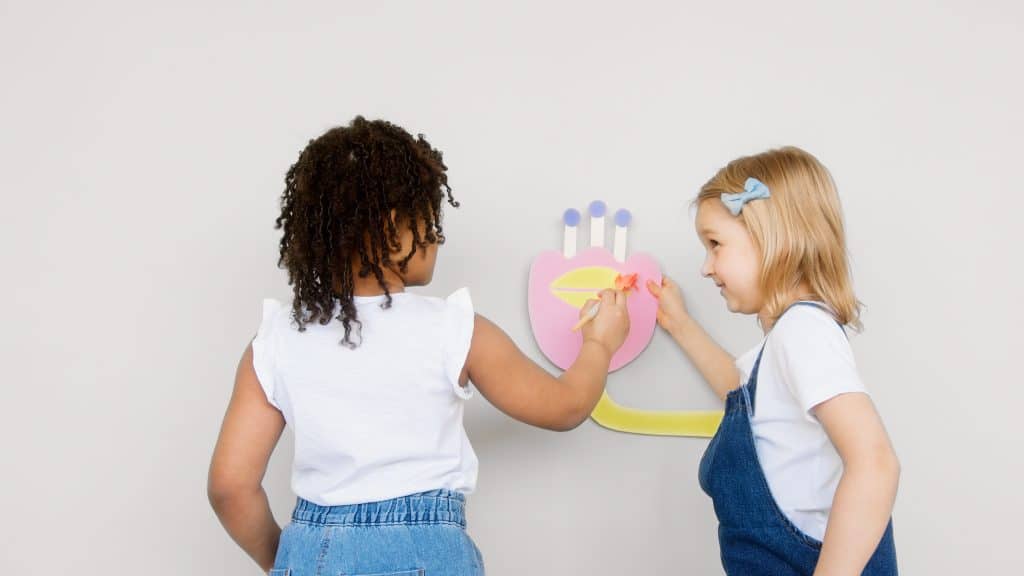Picture yourself walking into your child’s room, hearing them talk to someone. But when you look inside, there’s no one there. It’s just your child, happily chatting with their ADHD imaginary friend. You might wonder if this is something to worry about. Good news, having an imaginary friend is not only normal, but it can also show creativity and emotional intelligence in your child. In this blog post, we’ll explore imaginary friends and discuss their benefits and potential concerns. So, let’s learn more about these fascinating make-believe buddies!
Table of Contents
What Is an Imaginary Friend?
An imaginary friend is a made-up companion that children create in their minds. These friends can take many forms, like people, animals, or even magical creatures. Research shows that up to 65% of children have an imaginary pal at some point, usually between ages 3 and 7.
Why do kids create ADHD imaginary friends? There are several reasons. Sometimes, it’s just for fun and entertainment. Other times, kids might use this to help them understand the world around them or cope with difficult situations. No matter the reason, having an imaginary friend can be a healthy and normal part of childhood.
Why Imaginary Friends Can Be Good for Kids

Read more: How to Help Your Child Make Friends
ADHD Imaginary friends can offer several benefits for kids, including enhancing their creativity, social skills, emotional growth, and thinking skills. Let’s explore each of these benefits in more detail.
- Creativity: Having an imaginary sidekick can show that a child has a great imagination. Kids use their minds to create stories, characters, and situations with these friends, which can help them develop their creative thinking abilities.
- Social skills: Kids can practice talking and getting along with others by interacting with their imaginary friend. This helps them learn how to communicate, solve problems, and understand other people’s feelings. By practicing these social skills with their imaginary sidekicks, kids can become more comfortable in real-life social situations.
- Emotional growth: Children might use imaginary friends to help them understand and deal with their emotions. For example, they might talk about their feelings or find comfort in their imaginary friend when they’re sad. This emotional support can help kids learn how to process and manage their emotions in a healthy way.
- Thinking skills: Making up and remembering imaginary friendships can help kids improve their thinking and problem-solving abilities. Creating an imaginary friend requires a child to remember details, imagine scenarios, and think through complex situations, all of which can contribute to cognitive development.
Goally | The Tablet for Neurodiverse Kids

Common Concerns About Imaginary Friends
Even though imaginary friends are usually normal and healthy, some parents might still worry. Here are a few things parents often wonder about and some advice on how to handle these concerns:
Is My Child Lonely?
You might think that your child’s imaginary sidekick means they’re lonely or don’t have enough friends. But studies show that kids with imaginary friends usually have just as many real friends as other kids. If you’re still worried, try setting up playdates or helping your child join clubs to make new friends.
It’s important to remember that having an imaginary friend doesn’t automatically mean your child is lonely. In fact, interacting with imaginary friends can help kids develop the social skills they need to make real-life friends and connections.
Read More: Child Not Making Friends at School
Will My Child Stop Having an Imaginary Friend?
Most kids will stop having imaginary friends as they get older and make more real-life friends. This usually happens when they’re between 7 and 9 years old. If your child keeps relying on their imaginary friendship after this age, it might be a good idea to talk to a professional about it.
As children grow and develop, they often naturally outgrow their imaginary friends. They might find that they no longer need the emotional support, creativity, or social practice that their imaginary friend provided. This is a normal part of growing up and developing more advanced social and emotional skills.

Read More: 5 Books About Friendship for Kids
Supporting Neurodivergent Kids With Imaginary Sidekicks
For neurodivergent kids, like those with autism or ADHD, having an imaginary friend can help them cope with everyday life. These kids might feel safer and more understood with a friend who “gets” them. As a parent, be supportive of your child’s imaginary buddy and make sure they also have chances to make real friends and learn social skills.
Encourage your child to engage in social activities, playdates, or join clubs to foster new friendships. This can help them develop important social skills while still enjoying the benefits of their imaginary friend. Remember to be patient and understanding as your child navigates both the imaginary and real world of friendships.
Read More: Our 7 Favorite Friendship Quotes
When To Ask For Help
In most cases, having an imaginary friend is a normal part of growing up. But sometimes, it’s important to talk to a professional:
- Your child has trouble making real friends and depends too much on their imaginary sidekick.
- The imaginary playmate is causing problems or making it hard for your child to do everyday things.
- Your child blames their imaginary pal for bad behavior or uses them to avoid taking responsibility.
Keep an open line of communication with your child’s teacher or pediatrician, and don’t hesitate to reach out if you have concerns about your child’s imaginary sidekick or social development.

Try Goally For Your Child With ADHD
Goally is an excellent option for many families that have a child with ADHD. Use game play as a points-based motivator for your kiddo with ADHD, help them learn emotional regulation skills, and watch them grow! It’s simple to set up and has an expert-informed design.
Celebrating Imaginary Friendships
So, is it normal for your child to have an imaginary friend? Yes! This can help kids grow in creativity, emotions, and social skills. As a parent, try to understand and support your child’s imaginary sidekick while also helping them make real-life connections. Remember that having an imaginary friend is often a healthy, short-lived part of childhood that shows your child’s creative spirit.
FAQs About Imaginary Friends
What are the benefits of having an imaginary friend for a child? Having an imaginary friend can foster creativity, improve social skills, and aid emotional expression in children.
At what age do children typically develop imaginary friends? While it varies, many children develop imaginary friends between 3 and 5.
Should parents be concerned if their child has an imaginary friend? No, it's a normal part of child development. However, if the imaginary friend encourages harmful behavior, consult a professional.
How can parents interact with their child's imaginary friend? Parents can acknowledge the imaginary friend, show interest, and set boundaries as needed.
Can having an imaginary friend affect a child's social skills? Imaginary friends really enhance social skills, as children often practice communication and help them.
This post was originally published on 05/03/2023. It was updated on 04/17/2024.

Goally
We help parents teach their kids life skills, like doing bedtime and morning independently. Backed by science, we incorporate evidence-based practices and expert-informed designs in all of our apps and content.





